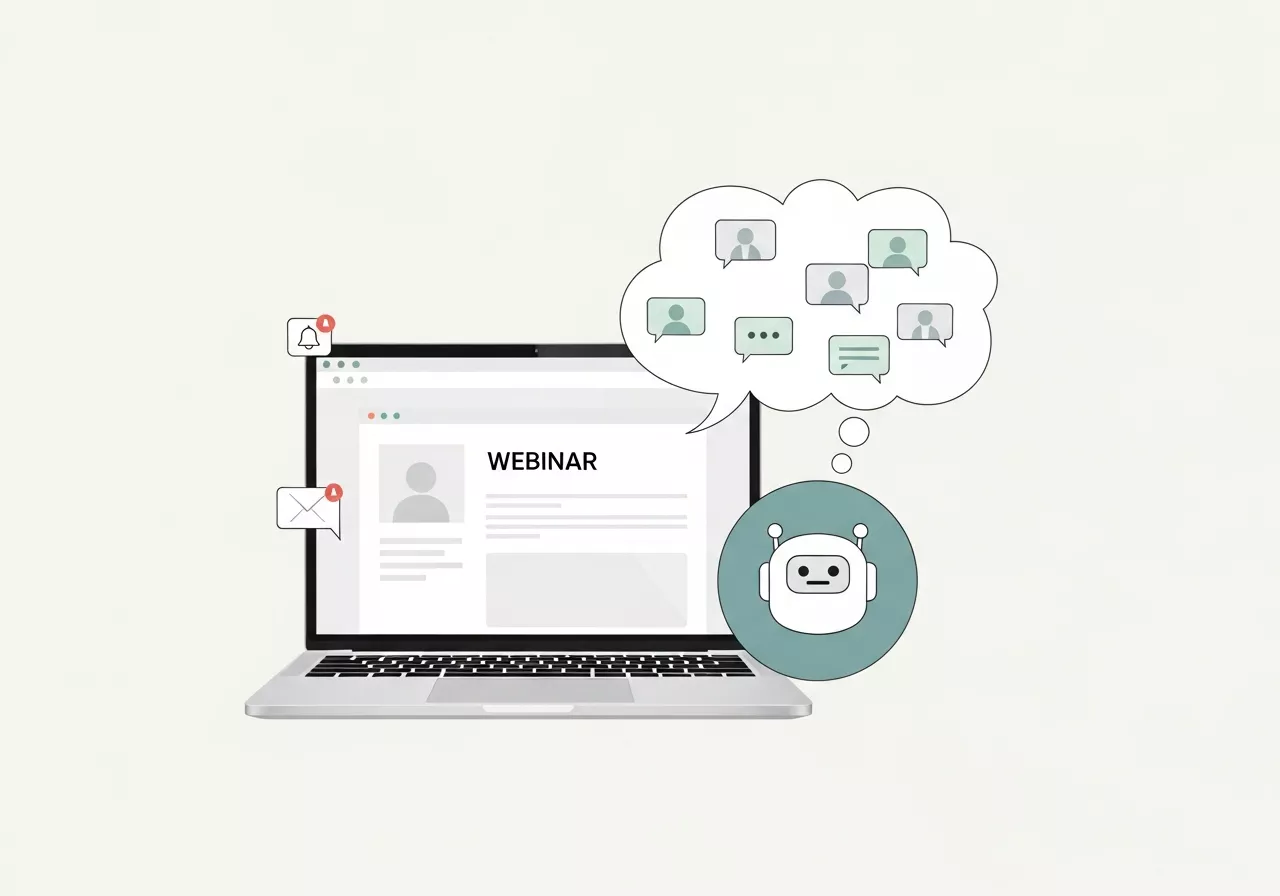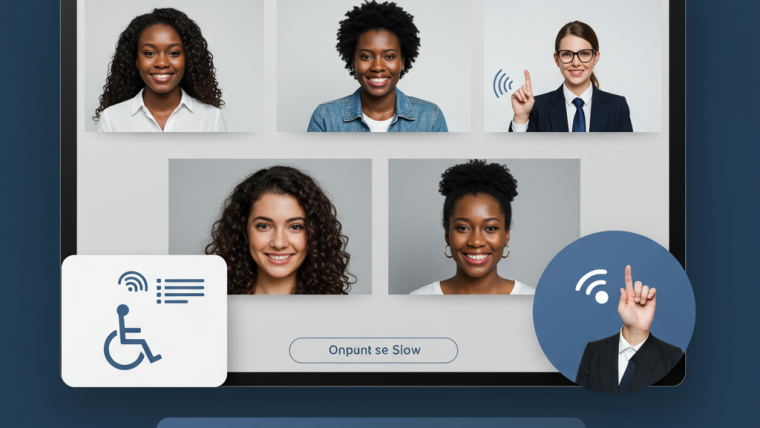AI transforms webinars by automating tasks, personalizing attendee experiences, and providing real-time insights. From chatbots and transcription to predictive analytics, AI enhances engagement, streamlines workflows, and improves ROI, enabling marketers to deliver smarter, more interactive, and data-driven virtual events.
Webinars have become a cornerstone of digital marketing, lead generation, and online education. As audiences grow more discerning, simply delivering a slide deck isn’t enough. Enter artificial intelligence (AI): a game-changer that can transform every aspect of your webinar—from promotion and registration to live engagement and post-event follow-up. In this guide, you’ll learn why AI matters for webinars, which tools to use, and how to implement them step by step to create a seamless, personalized experience for your attendees.
Why AI Matters in Modern Webinars

AI is no longer a buzzword—it’s a practical toolkit for automation, personalization, and data-driven decision-making. By integrating AI, you can:
- Boost Engagement with chatbots that answer FAQs instantly and AI-driven polls that adapt to audience mood. For example, a live AI poll can shift questions based on previous responses, keeping participants actively involved and tailoring content to audience preferences.
- Enhance Accessibility through real-time transcription and translation services, breaking down language barriers. This allows international attendees to follow presentations in their native language and ensures inclusivity for participants with hearing impairments.
- Automate Workflows from registration reminders to post-webinar follow-ups, freeing your team to focus on strategy. Automated email sequences, onboarding messages, and post-event surveys reduce manual effort and improve consistency across the attendee journey.
- Gain Insights via predictive analytics that identify hot topics, optimal broadcast times, and at-risk registrants. These insights help webinar organizers make data-driven decisions, anticipate attendance drop-offs, and focus on the content and interactions most likely to drive engagement and conversions.
Key AI Tools for Webinars

AI solutions span multiple categories, each enhancing a different phase of your webinar lifecycle:
- Chatbots & Virtual Assistants: Automate registration questions, troubleshoot login issues, and guide attendees through the interface. For instance, a chatbot can provide immediate answers about session timing, speaker info, or technical requirements, reducing support workload and improving attendee experience.
- Real-Time Transcription & Translation: Tools like Otter.ai or Microsoft Azure Speech Services convert speech to captions and translate on the fly. This ensures accessibility for international audiences and participants with hearing impairments, while also enabling accurate post-event documentation and searchable transcripts.
- AI Slide & Content Generators: Generate outline ideas, refine copy, or even produce entire slide decks based on your topic keywords. These tools save preparation time, maintain consistent messaging, and allow presenters to focus on engaging delivery rather than content creation.
- Sentiment Analysis: Gauge audience reaction from chat messages, facial expression data, or polling feedback to adjust your pace and tone. By understanding audience sentiment in real time, presenters can emphasize engaging topics or clarify confusing points to maximize impact.
- Predictive Analytics: Forecast attendance drop-off points, identify high-value leads, and optimize your email cadences. These insights allow organizers to target follow-ups, personalize communications, and proactively re-engage at-risk registrants, improving overall conversion and retention rates.
Personalization & Engagement
Personalization is key to maintaining attention in a crowded digital landscape. AI can deliver tailored experiences by:
- Dynamic Content: Present different slide variations or resource recommendations based on attendee industry, role, or interests.
- Behavior-Based Triggers: If an attendee lags, an AI assistant can prompt them to rejoin or offer on-demand access.
- Smart Q&A Moderation: Automatically filter and prioritize audience questions to focus on high-impact topics.
Automating Webinar Workflows
From the moment someone registers, AI can streamline outreach and nurturing. Automated workflows save time, reduce human error, and ensure consistent communication across the attendee journey. Consider these automated workflows:
- Pre-Event Reminders: Chatbots or email assistants send personalized countdown reminders via SMS or messenger apps. For example, reminders can include session highlights, speaker introductions, or login instructions, increasing attendance and reducing no-shows.
- Onboarding Tutorials: AI-driven walkthroughs familiarize first-time attendees with controls and features. Step-by-step guidance ensures participants understand navigation, polling, chat, and Q&A functions, improving engagement and reducing confusion during the live event.
- Post-Event Follow-Up: Segment attendees by engagement level and send targeted resources, surveys, or offers. Highly engaged attendees might receive premium content or invitations to future webinars, while less active participants receive recap materials to re-engage them effectively.
Real-Time Analytics & Insights
Live dashboards powered by AI give you a window into audience behavior. Track metrics like pulse score, attention span, and interaction hotspots. These insights provide actionable feedback that allows presenters to respond immediately and enhance the attendee experience.
- Adjust Delivery Speed or Switch Topics: Monitor attention drop-offs in real time and modify your pacing or focus areas to maintain engagement. For example, if engagement declines during a technical slide, a presenter can move to an interactive poll or demo.
- Identify Breakout Session Ideas: Analyze trending questions, popular discussion points, or high-participation topics to determine which breakout sessions will be most valuable for attendees. This ensures content aligns with audience interests.
- Benchmark Performance Across Multiple Webinars: Use historical data to compare metrics like engagement, participation rates, and interaction patterns. Benchmarking helps refine strategies, improve content design, and inform decisions for future webinars, creating a cycle of continuous improvement.
Step-by-Step Integration Guide
Ready to build an AI-powered webinar? Follow these steps:
- Audit Your Current Workflow: Map every stage from registration to post-event follow-up to identify manual pain points. Understanding where time, effort, or errors occur will help you pinpoint which processes benefit most from AI automation.
- Define Use Cases: Prioritize tasks for automation—chatbot Q&A, transcription, slide creation, or analytics. Focus on areas that save time, improve attendee experience, and provide measurable impact on engagement and conversions.
- Select Your AI Platform: Compare APIs and built-in webinar features in platforms like Zoom AI Companion, Microsoft Teams, or third-party integrations. Consider platform compatibility, ease of use, scalability, and available support for your team.
- Develop & Test Workflows: Use sandbox environments to configure chat flows, caption accuracy, and analytics dashboards. Testing ensures AI functions as intended, identifies bugs, and allows adjustments before live deployment.
- Train Your Team: Conduct internal dry runs so moderators and presenters understand AI prompts and overrides. Familiarity reduces errors during live events and ensures presenters can maintain a human touch while leveraging AI capabilities.
- Launch a Pilot Webinar: Invite a small segment of your audience to test new AI features and gather feedback. Pilots provide real-world insights on usability, engagement, and performance before scaling to a full audience.
- Iterate & Scale: Refine models and scripts based on pilot results, then roll out to your full webinar calendar. Continuous optimization ensures AI remains effective, improves attendee satisfaction, and maximizes the return on your investment.
Best Practices for AI-Driven Webinars

- Maintain Human Oversight: Always have a moderator review AI suggestions to preserve authenticity. While AI can provide recommendations for pacing, content, or audience interaction, human judgment ensures that the webinar remains natural, relevant, and aligned with brand tone.
- Prioritize Data Privacy: Ensure your AI vendor complies with GDPR, CCPA, and other regulations. Protect attendee information by implementing secure data handling, obtaining consent for AI tracking features, and clearly communicating how data will be used.
- Optimize for Mobile: Test AI features on smartphones and tablets for remote attendees. Ensuring a seamless mobile experience increases accessibility, prevents technical issues, and accommodates the growing number of participants who join webinars from mobile devices.
- Measure ROI: Track lead quality, attendance rates, and engagement lift to justify your AI investment. By quantifying the impact of AI-driven features on business goals, you can demonstrate value, refine strategies, and make informed decisions for future webinars.
Challenges & How to Overcome Them
AI integration isn’t without hurdles. You may face challenges like speech-to-text inaccuracies, data silos, or resistance from your team.
Speech-to-Text Inaccuracies: Errors in transcription can reduce accessibility and affect analytics. Mitigate this by using high-quality audio equipment, selecting advanced AI transcription tools, and reviewing transcripts for critical content.
Data Silos: Disconnected systems can limit insights and reduce the effectiveness of AI-driven workflows. Integrate data sources, centralize attendee information, and ensure smooth communication between platforms to fully leverage AI analytics.
Team Resistance: Employees may be hesitant to adopt AI due to unfamiliarity or fear of replacement. Address this by providing training, demonstrating AI benefits, and encouraging a culture of experimentation where staff feel comfortable testing and iterating new processes.
Mitigate these risks by setting clear performance benchmarks, investing in quality training data, and fostering a culture of experimentation. These steps help ensure successful AI adoption, maintain user trust, and maximize webinar engagement and ROI.
Future Trends & Conclusion
The intersection of AI and webinars is only getting started. Expect advances in immersive experiences—like AI-generated avatars, virtual reality breakout rooms, and emotion detection—to become mainstream. By adopting AI today, you’ll not only elevate your current events but also future-proof your webinar strategy against the next wave of digital innovation.
Start exploring AI tools now, pilot them on your next webinar, and watch as automation and personalization drive your engagement and conversion rates to new heights.
Frequently Asked Questions (FAQ)
1. How does AI improve webinars?
AI automates registration, Q&A moderation, transcription, slide creation, and analytics, while personalizing content to attendee interests, boosting engagement, and providing actionable insights.
2. Which AI tools are commonly used for webinars?
Tools include chatbots and virtual assistants, real-time transcription and translation, AI slide/content generators, sentiment analysis platforms, and predictive analytics software.
3. Can AI personalize the attendee experience?
Yes, AI enables dynamic content, behaviour-based triggers, smart Q&A filtering, and tailored recommendations to enhance engagement for each participant.
4. How can AI streamline webinar workflows?
It automates pre-event reminders, onboarding tutorials, live engagement, and post-event follow-ups, saving time and improving attendee satisfaction.
5. What metrics should I track for AI-powered webinars?
Track engagement rate, attention span, interaction hotspots, attendance, lead quality, and post-event conversion to measure success and optimize future webinars.
6. What are common challenges of integrating AI?
Challenges include speech-to-text inaccuracies, data silos, team resistance, and ensuring privacy compliance (GDPR/CCPA). Clear benchmarks and training mitigate these issues.
7. What does the future hold for AI in webinars?
Expect immersive experiences like AI avatars, VR breakout rooms, emotion detection, and hyper-personalized content to become mainstream.








Webinar Analytics: A Complete Guide to Measuring Success and Improving Performance
The Ultimate Webinar Follow-Up Strategy to Turn Attendees into Customers
Webinar Accessibility Best Practices: How to Make Your Online Events Inclusive for All
Webinar Personalization: Tailoring Content to Audience Segments for Maximum Engagement